Hunting and Fishing News & Blog Articles
Can a Bushcraft Knife and a Hunting Knife swap places and do as well?

Field-testing and comparing four different knives through a series of outdoor challenges
By Albert Quackenbush, Owner/Author of the SoCal Bowhunter Blog
Connect to social media at any given time of day and I will venture a guess that you will see someone sharing a post that includes a knife. Show me a hunter preparing for a weeklong hunt and he will have a sharp knife in his kit. Even survivalist types carry amazing knives for bushcrafting. There are endless uses for knives, but I had specific ideas in mind for this article. For the better part of a year, I have been testing four particular knives to see how well they would work in both bushcrafting and hunting scenarios.
Disclaimer: I am no survivalist or bushcrafter. I am a hunter through-and-through, but I do make my own fires and shelters from time to time.
| Knife | Blade Length | Knife OAL | Blade Thickness | Advertised Weight (Knife) | Actual Weight (Knife) | Weight (+Sheath) | Steel | Warranty | MSRP |
| ESEE AGK – Ashley Game Knife | 3.5″ | 8.25″ | .156″ | 5.1 oz | 5.5 oz | 7.6 oz | 1095 | Unknown | $166.00 |
| TOPS Fieldcraft B.O.B. | 4.625″ | 10″ | .190″ | 9.6 oz | 9.5 oz | 13.9 oz | 1095 | Unknown | $235.00 |
| Case Winkler Recurve | 4.8″ | 9.5″ | .24″ | 12 oz | 10.3 oz | 1 lb 1.5 oz | 80CRV2 | Unknown | $430.99 |
| Shay Butler Knives – Intrepid | 4″ | 9″ | .180″ | 6.8 oz | 6.8 oz | 9.3 oz | Stainless Steel with full heat treat | Lifetime | $525.00 |
Creating a Featherstick
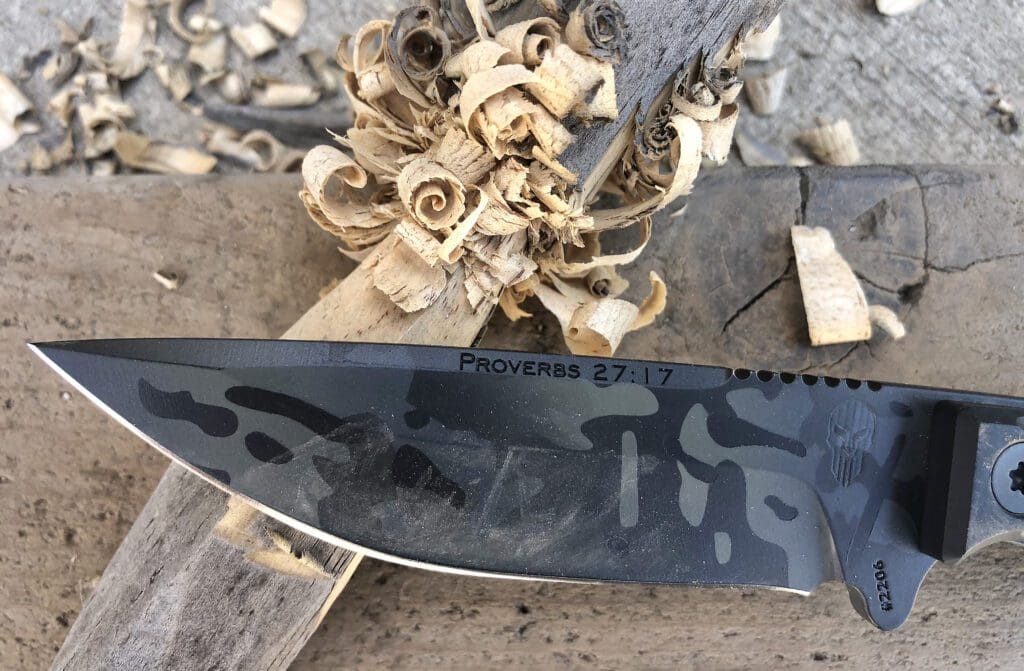
All four knives were sharp right out of the box. With little bushcrafting skill, I began testing these blades out with some simple tasks; making feathersticks, shaving bark, splitting wood and making a fire. It took me some time to get used to making a featherstick because the available wood was near a dried up riverbed. The heftier handled Case Recurve and TOPs BOB were easier to grip, where the ESEE had a smaller handle, but allowed for better control. The Shay Butler Intrepid surprised me with the best grip of all, but challenged me for making feathersticks properly, due to it being so sharp and having a steep angled blade.
Winner: ESEE Ashley Game Knife. 2nd place: Case Winkler Recurve
Shaving Bark
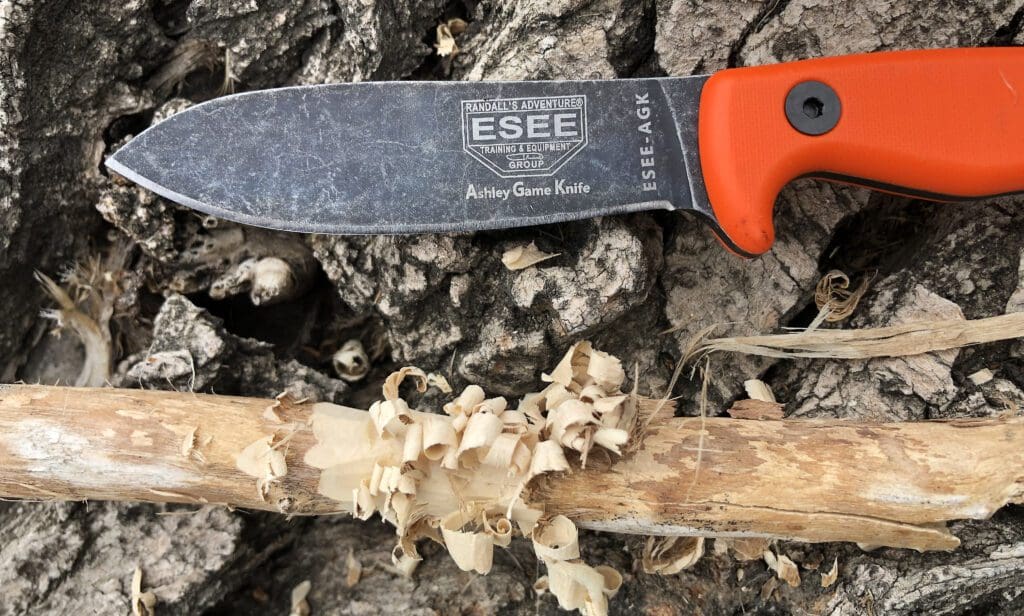
I found that shaving bark took a little less control as making a feather stick and the process went faster because I didn’t have to keep the shavings attached to the stick. As I tried different ways to shave the bark into thin strips, I figured out the Intrepid was easier to manipulate and control. The AGK was also easy to control. The Winkler Recurve allowed me to grip, shave and make short work of larger sticks for larger kindling. This one was tough because I felt the Recurve and Intrepid were extremely close in usability and function, but due to the combination of blade, weight and grip, the Case Recurve took this one over the Intrepid.
Splitting wood
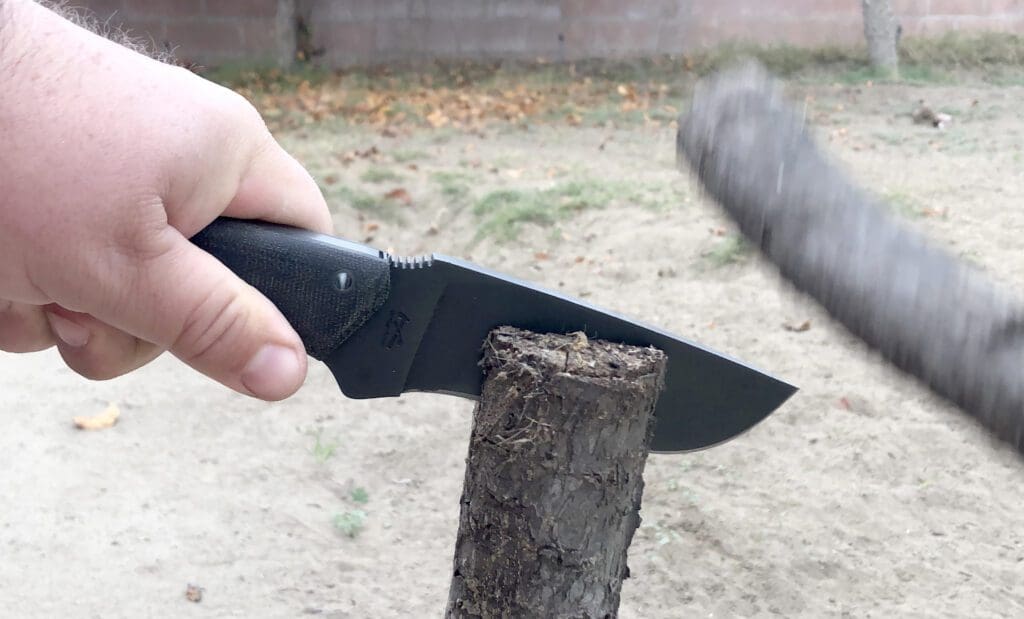
Each knife was used on some small logs and I used a baton to strike the spine to see which worked well. This was a new experience for me, but it didn’t take long to figure out.
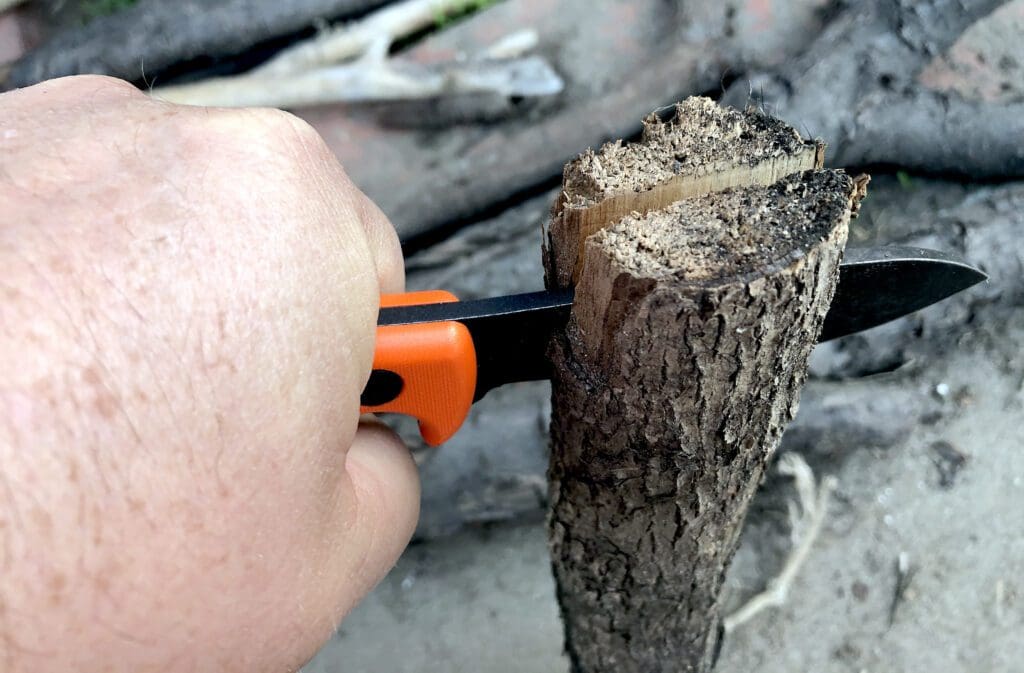 ESEE AGK and Shay Butler Intrepid – Each was easy to hold, strike and split small logs. They cut through wood like butter and made it fun.
TOPS Fieldcraft B.O.B. – Good balance and worked well. Longer blade was nice to baton against, but the width of the blade slowed down the process.
Case Winkler Recurve – Blade width made it slower to get through wood. Good use would be slight chopping.
ESEE AGK and Shay Butler Intrepid – Each was easy to hold, strike and split small logs. They cut through wood like butter and made it fun.
TOPS Fieldcraft B.O.B. – Good balance and worked well. Longer blade was nice to baton against, but the width of the blade slowed down the process.
Case Winkler Recurve – Blade width made it slower to get through wood. Good use would be slight chopping.
Starting a Fire
This part might be a little one (or two-sided) as two of the knives came with fire starting material. The Winkler Recurve comes with a Zippo lighter that attaches to the sheath. The Fieldcraft B.O.B. comes with a Ferro rod built into the Kydex sheath. The other knives did not have any additional equipment.
TOPS Fieldcraft B.O.B. – No contest here. The Ferro rod and the edge of the B.O.B. works great and give off a great spark. There are also small depressions cut into the handle to allow you to use a bow system to start a friction fire. Pretty cool feature that I did not master, but will continue to practice. Case Winkler Recurve – The Zippo is interesting, but it’s a bit gimmicky and it falls out of the Kydex often. A slight bump and it falls right out. Lighter fluid also give off a smell and as a hunter, I won’t be packing a Zippo to the woods. ESEE AGK – Combined with a Ferro rod and it works well. Shay Butler Intrepid – Combined with a Ferro rod and it works.Processing Game
The next step was processing wild game. I had not given any of the knives a new edge going into this test. I could have, but I wanted to see how sharp the knives would remain through the process. With multiple deer down, I had many opportunities to see how the knives would work. I used each knife to field dress, skin, debone, then trim, and cut each section of the deer. I worked hard at punishing the knives by hitting bone, trimming silver skin and then grinding it into the cutting board. Why? Let’s face it, it happens often and I wanted results.
Processing a deer with each knife forced me to slow down and be sure not to cut myself. Trust me when I say the knives were still sharp after hacking wood to bits. I’m going to highlight the order in which the knives performed for me during each task.
Field Dressing
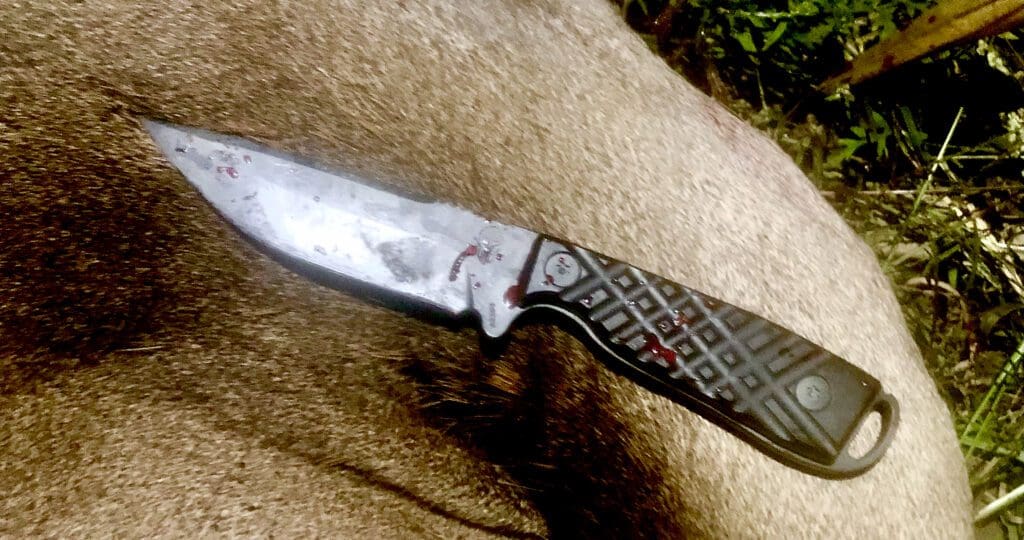 Shay Butler Intrepid – Razor sharp, lightweight, and the grooved handle allowed blood and fluid to drain while allowing my hand to keep a perfect grip.
ESEE AGK – Sharp, easy to control, and the orange grip is highly visible.
Case Winkler Recurve – Sharp blade, but the size of the blade was a bit much for me.
TOPS Fieldcraft B.O.B. – Solid, sharp, but a bit bulky for what I like.
Shay Butler Intrepid – Razor sharp, lightweight, and the grooved handle allowed blood and fluid to drain while allowing my hand to keep a perfect grip.
ESEE AGK – Sharp, easy to control, and the orange grip is highly visible.
Case Winkler Recurve – Sharp blade, but the size of the blade was a bit much for me.
TOPS Fieldcraft B.O.B. – Solid, sharp, but a bit bulky for what I like.
Skinning
Shay Butler Intrepid – Easy to control and being so sharp, it allowed me to work in record time. The grooved handle allowed tallow and blood to settle away from my hand. TOPS Fieldcraft B.O.B. – Large grip and blade allowed more focused strokes. Case Winkler Recurve – Heavy and after using it for a while, the blade started to get away from me as I cut. I ended up cutting the hide a few times because of this. ESEE AGK – Small handle and blade caused my wrist to ache and forced more strokes.Quartering the Deer
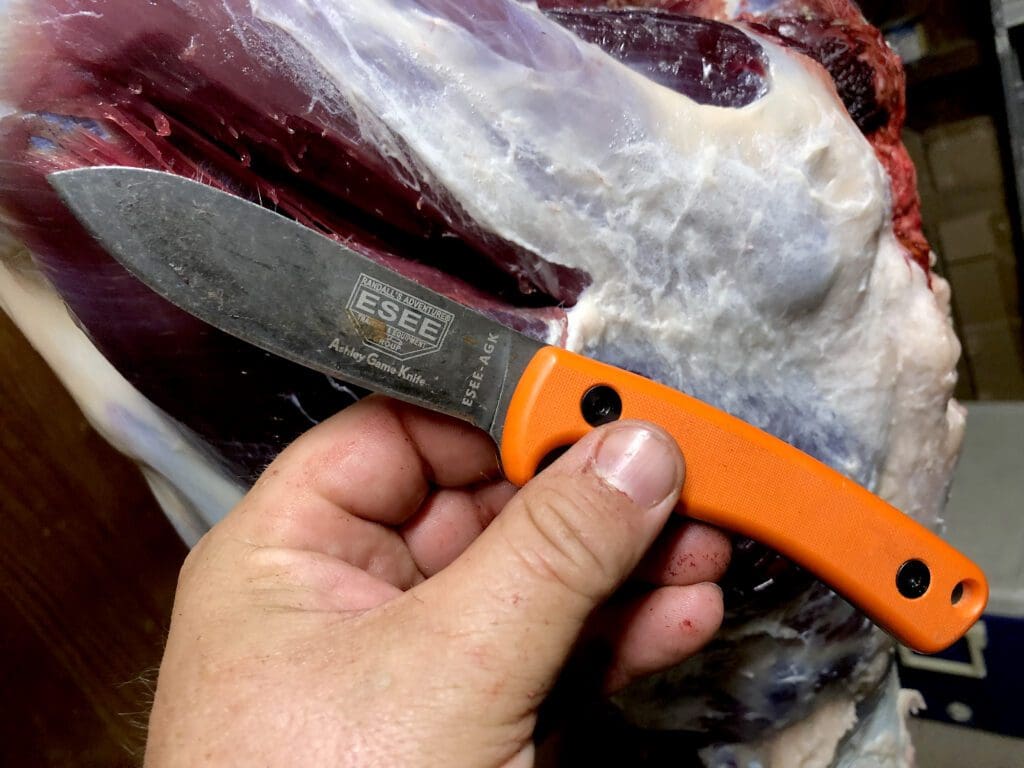 ESEE AGK – Acted like a perfect boning knife. Easy to control and I could feel how well the knife was working as I used it.
Shay Butler Intrepid – Sharp point and easy grip allowed me to get into crevices easily. Only reason it came in second was due to I felt I had slightly better control and maneuverability with the AGK.
TOPS Fieldcraft B.O.B. – My wrist and forearm got fatigued quickly. The longer blade made quartering more challenging than with the smaller knives.
Case Winkler Recurve – Heaviest of all when lifting it up over your waist. Not ideal for quartering a hanging deer.
ESEE AGK – Acted like a perfect boning knife. Easy to control and I could feel how well the knife was working as I used it.
Shay Butler Intrepid – Sharp point and easy grip allowed me to get into crevices easily. Only reason it came in second was due to I felt I had slightly better control and maneuverability with the AGK.
TOPS Fieldcraft B.O.B. – My wrist and forearm got fatigued quickly. The longer blade made quartering more challenging than with the smaller knives.
Case Winkler Recurve – Heaviest of all when lifting it up over your waist. Not ideal for quartering a hanging deer.
Cutting up the Meat (Trimming, Silver skin removal, Cutting to size)
At this point, it was obvious all of the knives needed a honed edge. I gave each knife a tune-up using a ceramic rod before we removed tallow, silver skin, and then cut nearly 60 lbs. of venison into cubes for grinding.
Shay Butler Intrepid – Sharp point and blade while removing silver skin and tallow. Grooved grip was great while cutting bloody meat and it was very comfortable in my hand. Case Recurve – Second to the intrepid due to being bulky, bit it’s wicked sharp. What I mean is that this knife was so sharp and slightly more difficult to handle that I trimmed off my fingernail and nearly cut myself two other times. ESEE AGK – Worked well, but didn’t stay as sharp as the previous two knives. TOPS B.O.B. – Better at bushcraft than processing game.These knives were well-used during many months of testing and all worked great, but each performed better than others for specific tasks. The question is, did they achieve the goal? Yes, a bushcraft knife can be used as a hunting tool and vice versa. On paper, my testing resulted in a tie between the ESEE Ashley Game Knife and the Shay Butler Intrepid. Personally, I feel the Intrepid edged out the AGK by a slim margin, but it is completely subjective. While the Intrepid costs more than 3x as much as the AGK, it fits me better as mainly a hunter who dabbles in bushcraft. If you plan to use a bushcraft-style knife as your hunting knife, practice with it. Make certain you bring the knife that suits you and the type of work you’ll be doing. I have much to learn about bushcraft and look forward to increasing my skill level over time. Be safe, carry a sharp knife and get out of your comfort zone. Test your skills and share your experience with others. If a hunter of nearly forty years can learn bushcrafting skills, you can, too.
The post Can a Bushcraft Knife and a Hunting Knife swap places and do as well? appeared first on HuntingLife.com.
Copyright
© Hunting and Hunting Gear Reviews
